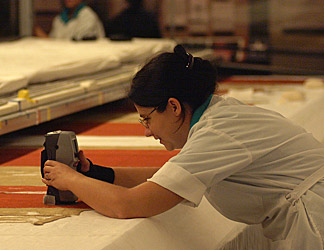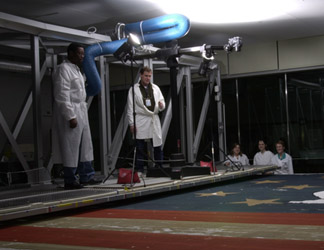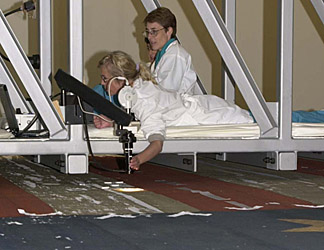Science of Preservation
Explore The Interactive FlagAll preservation projects involve meticulous study and planning before actual conservation work begins. The Star-Spangled Banner Preservation Project began with a careful examination of the flag, accompanied by extensive consultation with Museum curators and outside advisors. Conservation and textile specialists assessed damage to the flag by examining the flag’s fibers and dust vacuumed from the flag's surface. A 1996 conference brought experts together to consult on the treatment plan being developed by the Museum. In 1999, the Star-Spangled Banner was moved into a state-of-the-art laboratory to undergo extensive conservation treatment. Custom-designed to provide a safe, clean environment for the 30-x-34-foot flag, the lab had a glass wall so visitors could watch conservators working.
The Lyrics-

Taking pH Readings
Conservators took pH readings to measure the levels of acid or base in the fibers of the flag. Measuring the amount of acid enabled conservators to assess the amount of deterioration and the stability of the fibers, and helped them determine what type of cleaning was necessary.
-

Analyzing Color
Conservators examined the flag using a spectrophotometer, an instrument that collects color readings and helps analyze dyes. This non-destructive analysis helped conservators assess the true colors of the flag.
-

Documenting the Process
The Star-Spangled Banner was photographed at key points during the conservation. photographers took seventy-three individual shots that were spliced together on into a composite image of the flag.
-

Fiber Analysis
Conservators examined the flag both microscopically and macroscopically. Fiber analysis of sewing threads and visual observation helped determine the chronology of the many stains, mends, and patches found on the flag.
-

Intact Wool Fiber
The rod-like formation inside this white wool fiber from the Star-Spangled Banner is typical for wool that is in good condition. The fiber was deliberately broken to reveal its intact interior structure, which contrasts with that of a damaged fiber.
-

Damaged Wool Fiber
A damaged white wool fiber from the Star-Spangled Banner shows that the rod-like formations that appear in the center of normal fibers have physically broken down. Chemical exposure and actions like bending, crushing, and rubbing degrade the fibers and make them more susceptible to breaking.





